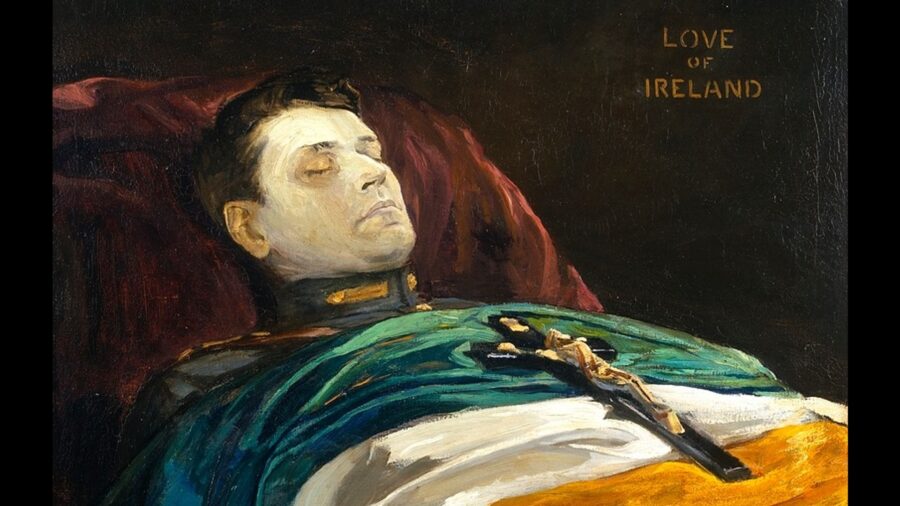
Kieran’s Our City, Our Town Article,
Cork Independent, 1 September 2022
Journeys to a Free State: The Burial of Michael Collins
The morning after the death of Michael Collins in Béal na mBláth on 22 August, his body lay in Cork City’s Shanakiel Hospital. From an early hour on 23 August, the surrounding roads leading to the hospital were packed with people.
The Cork Examiner records that some members of the public were admitted to the hospital grounds and a few had the honour to enter the room, where the body was lying in state. Officers of the National Army formed a guard of honour and the room was laden with floral tributes and choice blooms. Michael’s comrades including Major General Dalton, were present. Many citizens passed in and said a silent heartfelt prayer and departed again. A number of clergy were also present, including Most Rev Dr Cohalan, Bishop of Cork.
Meanwhile National Army troops lined up along the sweeping avenue to the hospital. About noon, the prayers for the dead having been said by Rev Scannell of Farranferris and the assembled clergy, the lid was placed on the coffin and removed to the hearse. The pall bearers were Major General Dalton, Colonel Commandant Kingston, General Liam Tobin, Colonel Commandant Vincent Byrne, Colonel Commandant Seán O’Connell and Lieutenant Commandant Dolan.
The order was given to the troops to reverse arms and the coffin was brought out followed by a group of nurses carrying the wreaths. The hearse moved down the ranks of the troops, and the military funeral procession went on its way.
As it proceeded on to Sunday’s Well, over Thomas Davis Bridge, Western Road, Washington Street, St Patrick’s Street, and down to Penrose Quay, where the remains were to be put on board a ship to be taken to Dublin, there were repeated deep lines of sorrow by the general public.
When it became known in the city that the body was going to be taken to Dublin by the SS Classic, people in large numbers thronged the quays, and by the time the funeral cortege approached St Patrick’s Quay and Merchants Quay mass crowds were present. The approaches to Penrose Quay were, however, guarded by National troops, and to prevent congestion, the public were not allowed nearer the SS Classic than the Brian Boru Bridge.
The SS Classic arrived from Fishguard at 10.30am, and the news of the death of General Collins caused grief amongst the passengers, many of whom were visibly affected. Captain Harrison was asked by the National Army for the vessel to convey the remains of Michael Collins to Dublin, and the necessary preparations were at once made.
At 1pm an armed guard with a machine gun went on board, and a little later the armoured car Slievenamon with her crew arrived, the armoured car being was also placed on board the vessel.
Throughout Cork all places of business were closed as a mark of respect to the memory of Michael Collins. The tricolour was flown at half-mast from all the buildings occupied by the National troops.
As the crowds became denser, members of the newly-formed Cork Civic Patrol, under Mr Jeremiah Murphy, assisted the military in keeping the quays clear. Their task was, however, an easy one, for the mourning citizens had only to be told once that their presence on Penrose quay would delay the troops and the transfer of the coffin to the ship.
Shortly after 1pm the funeral cortege moved slowly down Penrose Quay. Bishop Cohalan and several priests walked in front of the coffin, which was covered with the tricolour and borne in a hearse drawn by a pair of black horses. Behind it walked the relatives and friends of the deceased, well-known public men and political sympathisers, and finally the troops with arms reversed.
The Bishop, priests, and friends of General Collins went immediately on board. At 1.15pm the coffin was removed from the hearse, and was borne on the shoulders of General Dalton, General Tobin, Staff Captain McGrath, Commandant Friel, Staff Captain Courtney, and Captain Conroy to the vessel. It was received on board by the Bishop and the ship immediately departed.
Before the Waterford coast had been reached, a wireless message was picked up to the effect that the SS Lady Wicklow was on her way to Cork to convey the remains to Dublin, and that members of the Provisional Government were aboard. Passing Waterford, the SS Lady Wicklow was hailed and instructions communicated to her to return to Dublin. She immediately stopped and started her return journey. The SS Classic reached the mouth of Dublin Bay at 1am on 24 August.
The Cork Examiner records that the body passed through the silent streets of Dublin in the early morning. Over the cobbled quays the gun carriage, carrying the flag draped coffin, made its way. Despite the hour and the uncertainty of the time of arrival along the streets there were gathered with large groups of people.
The procession passed along the silent streets to St Vincent’s Hospital, Stephen’s Green. The remains lay in the mortuary with a guard of honour of military officers until about half-past nine the following morning, when they were removed to the Community Chapel.
Before the coffin was removed from the mortuary the blessing was given by Rev John McLaughlin, Acting Chaplain. Before being removed from the mortuary to the chapel the remains of Michael Collins were embalmed. In addition, Sir John Lavery painted the picture of Michael Collins as the body lay the coffin in the community chapel.
Michael Collins’ remains were removed at 7pm that evening to Dublin City Hall, where they laid in state until the following Sunday evening. They were then taken to the Pro-Cathedral. Solemn High Mass was be celebrated at 11am on the Monday morning, 28 August 1922 after which Michael Collins was buried in Glasnevin Cemetery.
Caption:
1166a. Painting of Michael Collins by Sir John Lavery, August 1922 (picture: Hugh Lane Gallery).